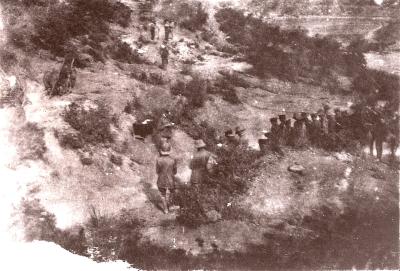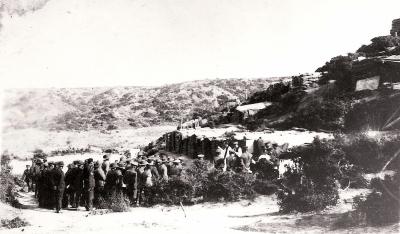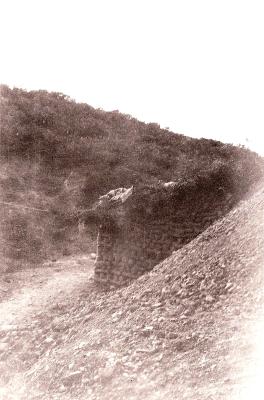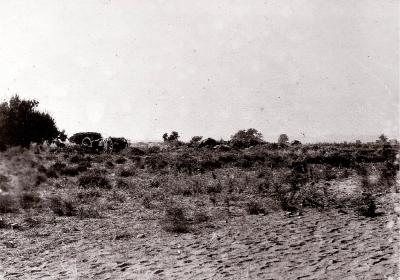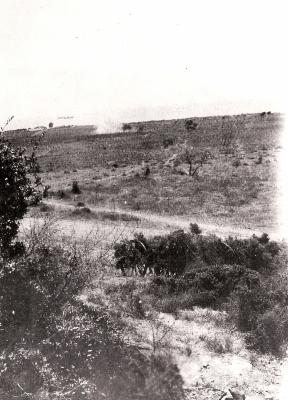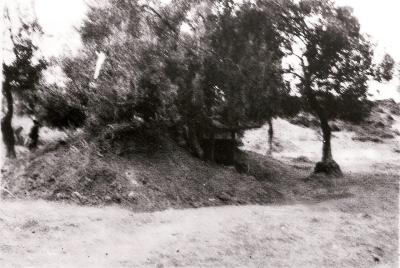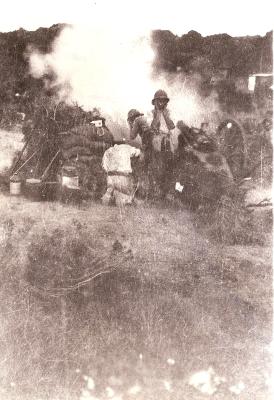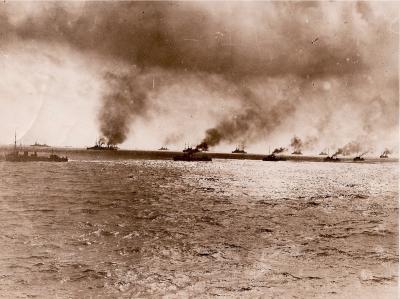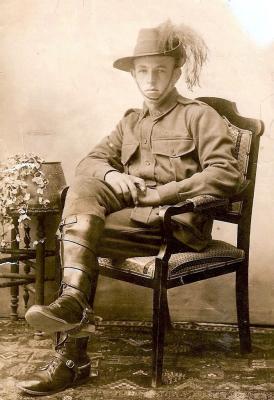World War 1, Europe Türkiye, Gallipoli, Anzac Cove, Shrapnel Valley, 1915
1915View of Monash Gully cemetery (Now designated Shrapnel Valley Cemetery)
The eight month campaign in Gallipoli was fought by Commonwealth and French forces in an attempt to force Turkey out of the war, to relieve the deadlock of the Western Front in France and Belgium, and to open a supply route to Russia through the Dardanelles and the Black Sea. The Allies landed on the peninsula on 25-26 April 1915; the 29th Division at Cape Helles in the south and the Australian and New Zealand Corps north of Gaba Tepe on the west coast, an area soon known as Anzac. Shrapnel Valley (or Shrapnel Gully) runs from the West side of the Lone Pine Plateau, behind Maclagan's Ridge, South-Westwards to the sea near Hell Spit (Queensland Point). The upper part was called Monash Gully (after Sir John Monash, then commanding the 4th Australian Infantry Brigade). The route up Shrapnel Valley was an essential road from the beach to the Anzac front and it took its name from the heavy shelling it was given by the Turks on 26 April 1915. Wells were sunk there and water obtained in small quantities, and there were camps and depots on the south side of its lower reaches. Gun positions were made near its mouth. The cemetery was made mainly during the occupation, but some isolated graves were brought in from the valley after the Armistice. There are now 683 Commonwealth servicemen buried or commemorated in this cemetery. 85 of the burials are unidentified but special memorials commemorate 23 casualties known or believed to be buried among them.
Details
Details
Open in Google Maps
Nearest geotagged records:
- World War 1, Australia, Western Australia, 372 BLAKE, 10 Light Horse (0.02km away)
- World War 1, 33 LAILEY, 10 Light Horse (0.02km away)
- World War 1, Australia, Western Australia, 878 LEWIS, 10 Light Horse (0.02km away)
- World War 1, Australia, Western Australia, 791 De MOLE, 10 Light Horse (0.02km away)
- World War 1, Australia, Western Australia, 148 GRAY, 10 Light Horse (0.02km away)
- World War 1, Europe Türkiye, Gallipoli, Anzac Cove, 11 Battalion, 1915 (0.02km away)
- World War 1 , Europe Türkiye Gallipoli, Anzac Cove, 1915 (0.04km away)
- World War 1, South-West Asia, Turkiye, Gallipoli, Anzac Cove, SILAS, "Crusading at Anzac" (0.07km away)
- World War 1, Europe Türkiye Gallipoli, 1915 (0.24km away)
- World War 1, South-West Asia, Turkiye, Gallipoli, Anzac Cove, SILAS, "Crusading at Anzac" (0.32km away)
Australian Army Museum of Western Australia
Australian Army Museum of Western Australia
Other items from Australian Army Museum of Western Australia
- World War 1, Europe Türkiye, Gallipoli, Anzac Cove, 1915
- World War 1, Europe, Türkiye, Gallipoli, Anzac Cove, 1915
- World War 1, Europe, Türkiye, Gallipoli, 1915
- World War 1, Europe, Turkiye, Gallipoli, Suvla Bay, Howitzers, 1915
- World War 1, Europe Turkiye Suvla Bay, Gallipoli, 1915
- World War 1, Europe Turkiye, Gallipoli, 1915
- World War 1, Europe, Turkiye, Gallipoli, 1915
- World War 1, Europe Türkiye, Gallipoli, 1915
- World War 1, Europe, Türkiye, Gallipoli, Suvla Bay,1915
- World War 1, Europe, Türkiye, Gallipoli, Suvla Bay, 1915
- World War 1, Europe, Türkiye, Gallipoli, 1915
- World War 1, Middle East, 10 Australian Light Horse, 484 SYKES, 1918
